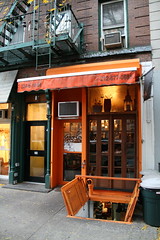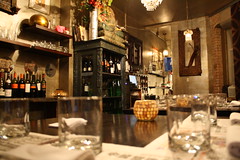New York will never die so long as gifted, passionate people from all over the world feel that it is here, and nowhere else, that they must make their mark. These brave souls don’t recoil from the city’s impossible demands; they turn those limitations into virtues.
Jehangir Mehta, the chef-owner of Graffiti, a shoebox-sized restaurant at 224 East 10th Street, came to New York from Mumbai to learn how to cook. He opened Graffiti in 2007 after working as a pastry chef at some of the city’s more grandiose establishments, including Jean-Georges, and after creating the Candy Camp, where he taught children how to make pastry. A gentle soul whose convictions were culinary rather than mercenary, Jehangir wanted a place that felt true to him. He found an abandoned handbag store with holes in the floor and the ceiling, a space where he could start from zero. The rent was $3,000, which meant that he could hire a sous-chef and break even with 15 customers a night. He had lines out the door the first week. He hired two more people. And he continued to do exactly what he thought was right.
Jehangir is a Parsee — a Persian Indian — and he describes Graffiti’s cuisine as “Persian and Indian spices with French and American technique.” I’ve never actually seen the menu; I don’t know whether anyone else has either. Jehangir produces and serves a degustation. His method is to build layers of texture and flavor, and he has trained the staff to explicate each dish accordingly. Thus Jehangir-style pork buns, perhaps my favorite of the whole oeuvre: “The pork has been braised” — for four to five hours, by the way — “in star anise and cinnamon; on top you have puffed rice, puffed corn and peanuts for crunch; and it’s sitting in bao, a Chinese bread, with apricot chutney” — a Persian specialty — “in the middle.”
All the patter about earthiness and crunchiness and coolness might feel precious in a more pompous setting; but Graffiti has the hectic gaiety of an impromptu salon. Jehangir wanted the effect of a living room, though he effect he got may be closer to a crowded curio shop. Glass-bead chandeliers hang from the ceiling; auspicious deities line the brick walls, with Ganesh and Lakshmi on one side, and a great seated Buddha on the other. The four tables seat a maximum of 24 diners without stacking people vertically, and guests are thrown together to fill up the space. The other night, my party of four sat with Rafael, a 23-year-old Colombian who works as a line cook at the terribly soigne restaurant Blue Hill; he sniffed and nibbled, and he and Jehangir engaged in high-level chef colloquy.
What is most wondrous about Graffiti is the relationship between the product and the means of production. For $3,000 a month you get a curio shop out front, and in the back not a kitchen but a galley. I came back a few days later, and Jehangir showed me around: two electric burners, an electric stove too small to roast a good-sized chicken, two rice-cookers for steaming, two pans — two pans! — three steel bowls, some small plastic tubs, two fridges under the counter and a dishwasher. That’s it. “Most chefs cook according to the season,” Jehangir said. “I cook according to the equipment. If I’m making an oven dish, I can’t replace it with something steamed, because the steamers are in use.” And yet with restraints any serious home cook would find intolerable, Jehangir produces his pork buns and his pizza with hummus and zucchini and his watermelon-feta salad and his hazelnut-chocolate cupcake with chocolate chip-chicory ice cream — three different forms of chocolate, if you’re counting.
Jehangir has immense brown eyes set in an austere oval face; he has an air about him of pious illumination. He has that lovely Indian accent, high and piping. And now he is famous. Jehangir has been celebrated by Martha Stewart, and was runner up in the second season of “Next Iron Chef.” He has just opened up Mehtaphor, a new place in Tribeca which has enough room for diners and cooks. But success has not spoiled him — he’s seen quite enough of that elsewhere — and something genuinely moral still informs the transaction between chef and diner at Graffiti. Jehangir has not raised the prices since he opened. He still charges $25 for every bottle of wine, as he always has. “I could have six other restaurants,” he said in the quiet dining room — Graffiti does not open for lunch —“but I doubt I will ever care about any of them as much — because of the simplicity and the love that this gives.” The feeling is mutual.
Graffiti, 224 East 10th Street, 212-677-0695.





